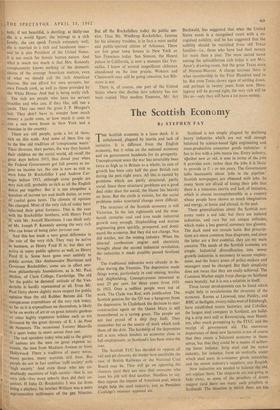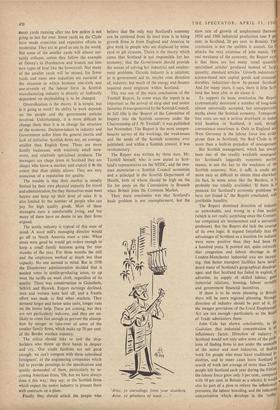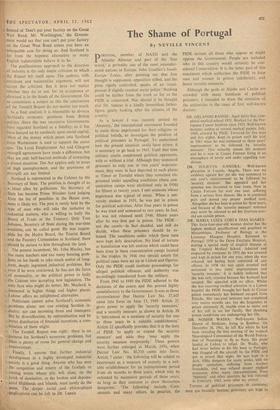The Scottish Economy
By STEPHEN FAY
THE Scottish economy is a lame duck. It is unbalanced, plagued by inertia and lack of initiative. It is different from the English economy, but it relies on the national economy and on government handouts for its prosperity. Unemployment since the war has invariably been twice as high as in Britain as a whole; its rate of growth has been only half the poor British rate during the past eight years. All this is caused by problems which are partly structural, partly social. Since these structural problems are a good deal older than the social, the blame lies heavily on them. But the circle is vicious, for the social problems make structural change more difficult.
The structure of the Scottish economy is still Victorian. In the late eighteenth and the nine- teenth centuries coal and iron made industrial growth easy enough. Shipbuilding and marine engineering grew quickly, prospered, and domi- nated the economy. But they did not change. Nor did textiles, nor the mining industry. 'When the internal combustion engine and electricity brought about the second industrial revolution, the industries it made possible passed Scotland by.
The traditional industries were already in de- cline during the Twenties. The depression made things worse, particularly in coal mining, textiles and shipbuilding. Unemployment remained at over 25 per cent. for three years from 1931 to 1933. Over a million people were out of work. The Clyde was Red, with justification. The Scottish passion for the Q3 was a hangover from the depression. In Clydebank the decision to start construction again on the Queen Mary is still remembered as a saving grace. The people are not just proud of a ship they built. They remember her as the source of work which took them off the dole. The hardship of the depression left a scar which hinders an economy close to full employment, as Scotland's has been since the war.
The Scottish TUC has decided to oppose all rail and pit closures, no matter how justifiable the case of British Railways or the National Coal Board may be. They will go on opposing the closures until they are sure that everyone who loses his job will find another. Needless to say, they oppose the import of American coal, which might help the steel industry, just as President Coolidge's minister opposed sin. Scotland is not simply plagued by declining heavy industries which are not well enough balanced by science-based light engineering and mass-production consumer goods industries: it has to live with a jobs mania too. Every industry, villether new or old, is seen in terms of the jobs it provides now, rather than the jobs it is likely to provide in fl. or ten years. The Government talks incessantly about 'jobs in the pipeline.' Scottish newspapers are obsessed with jobs. So many Scots are afraid of losing their jobs that there is a tenacious inertia and lack of initiative, which is almost incomprehensible in a country whose people have shown so much imagination and energy, at home and abroad, in the past.
These generalisations about the Scottish eco- nomy make a sad tale; but there are isolated industries, and rare but not unique attitudes, which make a less general summary less gloomy. The duck need not remain lame. But prescrip- tions are more common than diagnoses, and since the latter are a first essential, they are my main concern. The needs of the Scottish economy are simple. Industrial diversification into newer growth industries is necessary to secure employ- ment, and the hoary poses of policy-makers and managers must be changed. But their simplicity does not mean that they are easily achieved. The Common Market might force change on Scotland more brutally, but it is not a solution in itself.
Three recent developments can be listed which might help to revolutionise the structure of the economy. Rootes at Linwood, near Paisley, and BMC at Bathgate, twenty miles west of Edinburgh, have established motor factories; and Colvilles, the largest steel company in Scotland, are build- ing a strip steel mill at Ravenscraig, near Hamil- ton, after much prompting by the STUC and the receipt of government aid. The enormous importance of these new factories is not of course that they create a balanced economy in them- selves, but that they could be a means of achiev- ing better balance. Strip steel and the motor industry, for instance, form an 'umbrella under which steel users in consumer goods industries, and the motor industry's suppliers, can flourish.
New industries are needed to balance the old, not replace them: The shipyards are not going to fade away, as some of the prophets of doom suggest (and there are many such prophets in Scotland). The situation in which there are too many yards running after too few orders is not going to last for ever. Some yards on the Clyde have made conscious and expensive efforts to modernise. They are as good as any in the world. But some of the smaller yards will almost cer- tainly collapse, unless they follow the example of Denny's in Dumbarton and branch out into new types of boat like the hovercraft. Not many of the smaller yards will be missed, for fewer yards and more new industries are essential if the situation in which between one-sixth and one-seventh of the labour force in Scottish manufacturing industry is directly or indirectly dependent on shipbuilding is to be changed.
Diversification is the theory. It is simple, but is it going to work? Its ability to work depends on the people and the government policies involved. Unfortunately, it is more difficult to change them than it is to change the structure of the economy. Decision-takers in industry and Government suffer from the general inertia and lack of initiative. Scottish firms are, on average, smaller than English firms. There are more family businesses, with relatively small turn- overs, and relatively specialised products. The managers are chaps (even in Scotland they are chaps) who know a market, and exploit it tb the extent that their ability allows. They are very conscious of a reputation for quality.
The trouble is that their market is usually limited by their own physical capacity for travel and administration, for they themselves must meet buyers and keep up their level of sales. It is also limited by the number of people who can pay for high quality goods. Most of these managers earn a comfortable living, and too many of them have no desire to see their firms expand.
The textile industry is typical of this state of mind. A wool mill's managing director would go off to North America once a year. When times were good he would get orders enough to keep a small family business going for nine months of the year. For three months the mill and the employees worked at much less than capacity. No one seemed to mind. But in 1958 the Eisenhower administration decided that it needed votes in textile-producing areas, so up went the tariffs on wool cloth, regardless of its quality. There was consternation in Galashiels, Selkirk and Hawick. Export earnings declined, men and women were laid off, and a frantic effort was , made to find other markets. They demand larger and better sales units, longer runs on the looms help. These are coming, but they are not particularly welcome, and they are un- likely to come fast enough to prevent the absorp- tion by merger or take-over of some of the smaller family firms, which make up ,70 per cent. of the Border woollen industry.
The critics should take to task the ship- builders who throw up their hands in despair and cry, 'Our credit facilities are not good enough; we can't compete with these subsidised foreigners'; Or the engineering companies which fail to provide pressings to the specification and quality demanded of them, particularly by in- coming American firms, 'Oh, but we have always done it this way,' they say; or the Scottish firms which expect the motor industry to present them with contracts on a plate.
Finally they should attack the people who believe that the only way Scotland's economy can be retrieved from its inert state is to bring growth firms in from England and America to give work to people who are displaced by mine, yard or pit closures. Theirs is the theory which states that Scotland is not responsible for her economy; that the Government should provide the means of solving her industrial and employ- ment problems. Outside industry is a solution; so is government aid to, maybe even direction of, industry; but much of the energy and finance required must originate within Scotland.
This was one of the main conclusions of the Toothill Report. In some ways the report is as important as the arrival of strip steel and'motor factories. It was sponsored by the Scottish Council; its full title is the 'Report of the Committee of Inquiry into the Scottish economy under the Chairmanship of J. N. Toothill'; it was published last November. The Report is the most compre- hensive survey of the workings, the weaknesses and the needs of the Scottish economy ever published; and within a Scottish context, it was revolutionary.
The Report was written by three men, Mr. Toothill himself, who is now seated as Scot- land's representative on the NEDC, and the two- man secretariat—a Scottish Council economist and a principal in the Scottish Department of Health, both of whom should be high on the list for posts on the Commission in Brussels when Britain joins the Common Market.
Their main conclusion was that Scotland's basic problem is not unemployment, but the 'Arise, ye starvelings, from your slumbers,. Arise, ye prisoners of want. . . slow rate of growth of employment (between 1954 and 1960 industrial production rose 9 pet cent. in Scotland, 20 per cent. in Britain). Thi conclusion is not the quibble it sounds, for it attacks the very existence of jobs mania. The real weakness of the economy, the Report says, is that there are too many 'small quantity', specialised articles' produced instead of large quantity, standard articles,' Growth industries-- science-based new capital goods and consumer durables industries—have by-passed Scotland. And for many years, it says, there is little Scot, land has been able to do about it.
- To support its basic conclusion the Report systematically destroyed a number of long-held.
almost universally accepted, but unsupportable myths about the Scottish economy. Transports' tion costs are 'not a serious drawback to indus• trial location in Scotland, it - said, the ugb convenience sometimes is. Only in England and West Germany is the labour force less strike' prone than in Scotland; the Red Clyde is ne more than a built-in prejudice of management But Scottish management, which has alway's been one of the readily available scapegoat!
for Scotland's laggardly economic perfor mance, is not the key to the weakness of the Scottish economy. Nor, it saki, is credit anY more easy or difficult to obtain than elsewhere (in fact, in some areas like the Borders, it j5 probably too readily available). 'If there is 8 panacea for Scotland's economic problems W8 have not found it,' the Report concluded, with justifiable humility.
The Report dismissed direction of industrY as unworkable, and wrong in a free society' (which is not really surprising since the Commit' tee comprised six businessmen and a universil professor). But the Report did lack the courage of its own logic. It argued forcefully that the advantages of Scotland as a location for industrY were more positive than they had been fat a hundred years. It pointed out, quite correctlYi that congestion and labour shortage in the London-Manchester industrial axis are increas' ing; that better transport facilities have invall' dated many of Scotland's geographical disadvaa' ages; and that Scotland has failed to exploit, 81 advertise, its supply of skilled labour, good industrial relations, housing, labour mobilig and government financial incentives.
If there is to be more planning in Britain, there will be more regional planning. Strong°. direction of industry should be part of it; far the meagre provisions of the Local Employment Act are not enough—particularly as the Board of Trade administers them.
John Cole has shown conclusively, in 01° Guardian, that industrial concentration is 8° inflationary factor. Direction of industry 1° Scotland would not only solve some of the prolr lems of finding firms to put under the umbrella of the motor and steel industries, of finding work for people who must leave traditional in' dustries, and in many cases leave Scotland search of work (an average of more than 25,00u people left Scotland each year during the Fifties; the labour force grew only 3 per cent., compared with 10 per cent. in Britain as a whole). It would • also be part of a plan to relieve the inflationall pressures, the labour hoarding, and the industrial, concentration which develops in the 'coffin. Instead of 'Don't put your factory on the Great West Road, Mr. Worthington,' the Govern- ment would say that you can't put your factory on the Great West Road unless you have an unarguable case for doing so. And Scotland is far from the hopeless alternative so many English industrialists believe it to be.
The pusillanimous approach to the direction of industry is the only major criticism to which the Report left itself open. The authors, with ti enchant and businesslike argument, will not accept the criticism. But it does not matter whether they do or not, for its acceptance or ,dismissal is in the hands of the Government. On as contentious a subject as this the conclusions of the Toothill Report do not matter too much.
In a final analysis it is impossible to divorce Scotland's economic problems from British Politics. Since the war successive Governments have regarded Scotland as a liability, so it has been buoyed up by carelessly spent social capital. Most of the money which pours into Scotland from Westminster is used to support the status quo. The Local Employment Act and Glasgow overspill agreements have made a difference, but they are only half-hearted methods of correcting a dismal situation. The Act applies only to areas of high unemployment, and the provisions of overspill are too limited.
Scotland is represented in the Cabinet by the Secretary of State. The position is thought of as a blind alley by politicians. No Secretary of State has become Prime Minister (and judging from the list of possibles in the House now, none is likely to). The post is rarely held by the type of man who will take the initiative in industrial matters, who is willing to bully the Board of Trade or the Treasury. Only Tom Johnson, Secretary of State during the war-time coalition, can be called great. He was respon- sible for the Hydro Board, the Tourist Board and the Forestry Commission in Scotland; there Should be statues to him throughout the land.
Hie present incumbent, Mr. John Maclay, has too many teachers and too many housing prob- lems on his hands to take much notice of long- term, deeply ingrained industrial problems. But even if he were concerned, he has not the force of personality, or the political power to bully the Cabinet into accepting new legislation. The only Scot who might do better, Mr. Macleod, is interested in higher things and higher places. labour offers no enlightened alternative.
Politicians cannot solve Scotland's economic problems alone; nor can existing Scottish in- dustry; nor can incoming firms and managers. But by diversification, by rationalisation and by better distribution of financial incentives, a com- bination of them might.
The Toothill Report was right: there is no panacea for Scotland's economic problems, but there is plenty of room for general change and improvement.
Finally, I assume that further industrial development in a highly developed industrial society is a good thing. Anyone who has seen the congestion and misery of the Gorbals or mining towns whose pits will close, on the brink of desolation, or the broken and depopu- lated Highlands and Islands, must surely do the same. The deeper social Wand philosophical implications can be left to Dr. Leavis.




































 Previous page
Previous page